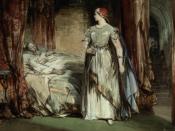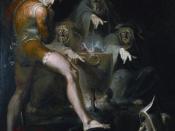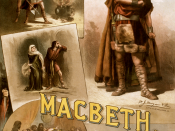Discuss the use of foreshadowing in Macbeth
Any drama text can utilise the idea of foreshadowing. Macbeth, by William Shakespeare is an example of a drama text which develops and uses the literally technique of foreshadowing throughout the play. The protagonist, Macbeth, undergoes forms of emotional, physical and psychological pain through the use of foreshadowing. The use of witches, apparitions and ghosts provide important elements in making the play interesting and to develop the climax and 'excuses' for Macbeth's change of character. It is Macbeth's change in character through his tragic pursuit of his ambitions and listening to the prophecies that brings him to such an ironic, tragic downfall.
The play opens with the use of foreshadowing when three witches are chanting around a steaming cauldron. Here, they proceed to predict Macbeth's fate. The three witches have an important role in the use of foreshadowing because their prophecies are the motivation for Macbeth's actions.
Appearing in the first act of the play shows the significance of the witches and their prophetic powers. This gives the audience a glimpse of what will follow. "When the hurlyburly's done, When the battles lost and won..." (I,i lines 3-4) suggests that the witches will meet again. It can also be noted that the witches meet after every battle is lost and won. Every battle, whether man against man or man against himself will always be lost by one side and won by another. Eventually Macbeth will lose the battle for his soul (a battle against himself). 'The witches reveal a fate for Macbeth and imply that a part of what will come to him must come, but they reveal no fate of evil-doing for him and never, even by suggestion, bind him to evil doing'(^1). By using foreshadowing, Shakespeare creates the witches who offer...


